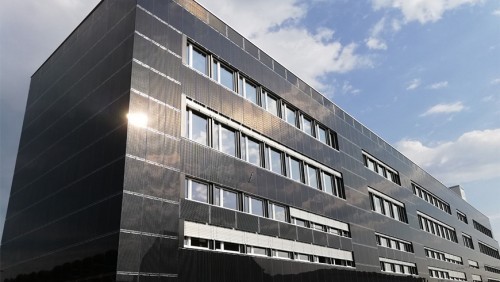An empa research team has calculated what it will take to achieve the 1.5% global warming target after all
Who would get on an airplane that only arrives at its destination with 50% certainty?" ask Harald Desing and Rolf Widmer right at the beginning of their publication. On our journey into the future with Spaceship Earth, we don't have the choice of getting on or off the plane. It is therefore all the more astonishing that even with the optimistic transition paths of the IPCC (Intergovernmental Panel for Climate Change), the chances of limiting global warming to 1.5°C are only 50%.
Radically simplified approach
 This solar façade on the K3 Handwerkcity building in Wallisellen has been in operation since 2020 (Photo: die werke versorgung wallisellen ag)So the two researchers from the Swiss Federal Laboratories for Materials Science and Technology (empa) thought that we need to do more to increase the chances of a safe future. And they started doing the math to find the physical limit for accelerating the energy transition. With the help of a model that was specially developed for this purpose in Empa's "Technology and Society" research department, they simplified the global economy into a radical, clear picture: there is a "fossil machine" that combines all of today's non-renewable energy systems and converts fossil fuels into electricity. And there is a "solar machine" that generates electricity from sunlight.
This solar façade on the K3 Handwerkcity building in Wallisellen has been in operation since 2020 (Photo: die werke versorgung wallisellen ag)So the two researchers from the Swiss Federal Laboratories for Materials Science and Technology (empa) thought that we need to do more to increase the chances of a safe future. And they started doing the math to find the physical limit for accelerating the energy transition. With the help of a model that was specially developed for this purpose in Empa's "Technology and Society" research department, they simplified the global economy into a radical, clear picture: there is a "fossil machine" that combines all of today's non-renewable energy systems and converts fossil fuels into electricity. And there is a "solar machine" that generates electricity from sunlight.
Since the solar potential on the already sealed roofs, facades, parking lots and other infrastructure is sufficient for the turnaround, neither greenfield solar parks nor huge wind farms are needed. Clearly, we need to switch off the fossil fuel machine as soon as possible and build and start up the other, solar machine. First of all, building the solar machine requires energy, which at the start of the energy transition can only come from the fossil machine. How can we achieve this with the lowest possible cumulative emissions? Because the temperature of the atmosphere does not depend on current emissions, but on total emissions - including past emissions.
Full throttle, then hard on the brakes
The two researchers have calculated several scenarios and have come to a clear conclusion: We would now have to run all fossil fuel power plants at full capacity if possible and put the additional energy thus gained into building the solar engine. "Our simulation shows that the fastest possible conversion of the energy industry generates the lowest cumulativeCO2 emissions," says Desing. Paradoxically, this means that fossil emissions increase by up to 40% during the transition with the aim of building solar infrastructure. This means that the energy transition could be completed within five years, resulting in the lowest cumulative emissions. After that, the fossil engine can be turned off for good.
However, even the fastest possible energy transition still leads to a 20% probability of exceeding the 1.5 °C target. We can't go below that, it's already too late. And every year we wait increases this probability further.
Conclusion:
Theoretically, it would still be possible to reduce the probability of exceeding the climate target of 1.5 °C to below 50% - but only if we accelerate the energy transition now. The research work was funded by the Swiss National Science Foundation (SNSF).


